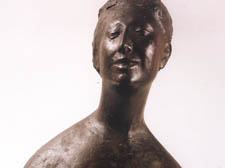|
|
 |
| |

Giacomo Manzú: Bust of a Woman, 1952 |
Looking back to the Futurists’ legacy
Simon Wroe meets a remarkable collector whose gallery is celebrating its 10th anniversary
AT last mythology and the mystic cult of the ideal have been left behind.
We are going to be present at the birth of the centaur and we shall soon see the first angels fly! We must break down the gates of life to test the bolts and the padlocks!”
With these words, Filippo Tommaso Marinetti gave flight to the Futurist movement. His 1909 manifesto espoused a love of speed and a predilection for technology over weak, tearable flesh.
He urged violence in all forms of creativity, and spurned the “fanatical, senseless and snobbish religion of the past”.
Marinetti’s Futurist hyperbole has now been consigned to the same dustbin of history it once regarded with such scorn, along with the great artists of the movement – Balla, Boccioni, Carra.
But the Estorick Collection’s new exhibition shows the art itself, for the most part, still bears scrutiny.
A Decade of Discovery portends to display the fruits of the gallery’s first 10 years since its founding in 1998, but the story goes back much further to the collection’s father, Eric Estorick.
Born in Brooklyn in 1913 to Russian-Jewish parents, Estorick was primarily a writer and sociologist.
The fact that his father worked in a paint factory was probably the closest claim the young Estorick had to an artistic sensibility: he was short-sighted and partially colour blind to boot.
But he was adamant his love of art was sufficient, claiming: “You don’t really have to be a good painter to have an eye and be a good collector... I have always regarded art as being the God centre of the altar at which I have always kneeled my entire life and in front of which I shall die and die happily.”
At 25 he had already bought a primitive Cezanne and a Modigliani caryatid with his modest earnings but it was on his honeymoon with his wife Salome that the object of his desire was sealed.
Seeing the torn pages of Boccioni’s book, Futurist Painting and Sculpture, Estorick fell headlong into modernist Italian art.
Under Salome’s keen eye, he purchased and dealt work by Giorgio de Chirico, Balla’s The Hand of the Violinist (1912), Boccioni’s Modern Idol and Luigi Russolo’s kaleidoscopic masterpiece Music, establishing close friendships with the artists Camigli, Severini and Zoran Music.
For some, a shadow continues to hang over Futurism due to Marinetti’s links with Mussolini, but the collection remains an absorbing insight into the mind of Eric Estorick; a true art zealot.
|

|
 |
|
 |
|

